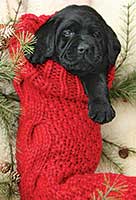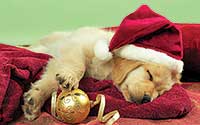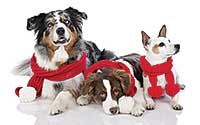 Whether you adopted, or purchased a puppy for the holidays you have a new life and member of the family now. With all the joy can come reality, stains on the carpet, chewed holidays goodies, barking, and destruction. A new dog can be the best thing ever, but like much of the holiday excitement a pet can’t be put away and ignored until next year. What can you do to help your puppy become a happy well-adjusted dog? First let’s address some common misconceptions about when to start. Whether you adopted, or purchased a puppy for the holidays you have a new life and member of the family now. With all the joy can come reality, stains on the carpet, chewed holidays goodies, barking, and destruction. A new dog can be the best thing ever, but like much of the holiday excitement a pet can’t be put away and ignored until next year. What can you do to help your puppy become a happy well-adjusted dog? First let’s address some common misconceptions about when to start.
Many puppy owners are understandably confused by conflicting opinions on whether it’s best to keep pups isolated from other animals until they are fully immunized, or whether insuring they are properly socialized during the critical developmental stage of 4 to 16 weeks is more important.
To better assess the real risk of infection with parvovirus, and to offer better guidance to puppy parents, researchers at the University of California-Davis School of Veterinary Medicine conducted a study to determine if puppies 16 weeks and younger that attend puppy socialization classes are at increased risk of contracting a parvovirus infection.
The UC Davis researchers collected data from 21 clinics in both high- and low-income areas in four U.S. cities with clear seasonal patterns. The clinics provided records of puppies examined between birth and 16 weeks that included their sex and breed, parvo vaccination status, parvo infection status, and whether the pup had attended socialization classes.
The information the researchers collected from the clinics included over 1,000 puppies. Only about 5 percent attended puppy socialization classes, about 87 percent did not, and for the remaining dogs there was no information available. None of the dogs that attended socialization classes were diagnosed with parvo; 14 of the dogs that did not attend classes acquired the infection. From 24 local dog trainers, the researchers gathered information on 279 puppies, none of which were suspected of having or were diagnosed with a parvo infection.
These study results indicate that puppies 16 weeks of age or younger that were vaccinated at least once and attended socialization classes were at no greater risk of developing a parvovirus infection than puppies that did not attend classes. So now you know, the socialization process can start at 7 to 8 weeks and should continue throughout your pet’s life, not just until you hit the 16 week mark.
 Veterinarians now understand the far-reaching consequences of unsocialized puppies who may mature into unbalanced adult dogs. Most believe the risk far outweighs the chance that a partially immunized puppy will contract an infection at a socialization class. Veterinarians now understand the far-reaching consequences of unsocialized puppies who may mature into unbalanced adult dogs. Most believe the risk far outweighs the chance that a partially immunized puppy will contract an infection at a socialization class.
Vets don’t recommend visits to the dog park until a puppy is at least six months old, but most recommend professionally run positive training classes as soon as possible (around 10 weeks of age) to help young dogs acquire critically important social skills.
Socialization means exposing your puppy to as many new people, animals, environments and other stimuli as possible without overwhelming him. Over-stimulation of a young puppy can result in excessive fear, withdrawal or avoidance behavior, so knowing how much is enough is important. Invite friends and family over to meet and interact with your puppy. Try to include people of varying ages and ethnicities, especially children if you don’t have any, and both genders. Also invite gentle, healthy dogs, puppies and cats to your home to meet and interact with your pup. You can also take your puppy for visits to other pet-owning households. Take the time to really assess the new exposure and make sure you know it will be a positive one.
A well-socialized puppy is:
• Handled from birth and learns to accept touching of all body parts
• Exposed to as many people, other animals, places and situations as possible
• Encouraged to explore and investigate his environment
• Allowed to experience a variety of toys and games, surfaces and other stimuli
• Brought along often on car rides to new environments with his owner
Socialization should engage all of your puppy’s senses though exposure to the sights, sounds and smells of daily life. This exposure will help your pup develop a comfort level with new and different situations, with the result that he’ll learn to handle new experiences and challenges with acceptable, appropriate behavior.
Dogs that have not been adequately socialized often develop entrenched fear responses and generalized anxiety, resulting in behavior problems that can make them unsuitable as family pets. In fact, almost half of all dogs relinquished to shelters have at least one behavior problem – aggression and destructiveness are among the most common. These behaviors often originate from the fear and anxiety that develops as a result of improper or incomplete socialization.
The goal of socialization is to help your puppy grow into a well-adjusted adult without behavior problems. Now that you know there is minimal exposure to health risks, socialization can deliver tremendous benefits for both of you, including:
• Increasing your pup’s responsiveness to commands
• Teaching bite inhibition through puppy play, and proper interaction with people, including strangers
• Learning tips for successful housebreaking and how to prevent hyperactivity – two of the most common reasons given by owners who relinquish their dogs to shelters
• Developing realistic expectations for your dog
• Strengthening your bond with your puppy
Make sure your puppy is exposed to unfamiliar or out-of-place objects around your house so he’ll be less likely to startle or be fearful of changes in his environment. It’s also important to get your puppy accustomed to hearing a variety of sounds, for example, the vacuum cleaner, the lawn mower, outside traffic, a blow dryer, a plastic or paper trash bag being snapped open, the TV, radio, video games, etc. The goal is never to frighten your pup, but to expose him to new sounds. Life is noisy; your pet needs to learn that everyday sounds are non-threatening.
Get your puppy used to being bathed and brushed, having her nails clipped, her teeth brushed, and her ears and other body parts handled and examined. This will help her get used to being handled, which will make future baths, nail trims, oral care, and visits to the vet and groomer easier on everyone involved.
 Keep things positive. You should start socializing your pup from his first day home with you, but don’t overwhelm him. Set the stage and then let him set the pace. Don’t hurry or force his progress, and keep socialization sessions frequent but brief, and always upbeat. When your puppy shows hesitance or fear, resist the urge to reward fearful behavior with a lot of attention and affection. Stay close to reassure him he’s safe, but take care not to inadvertently reinforce unwanted behavior. Keep things positive. You should start socializing your pup from his first day home with you, but don’t overwhelm him. Set the stage and then let him set the pace. Don’t hurry or force his progress, and keep socialization sessions frequent but brief, and always upbeat. When your puppy shows hesitance or fear, resist the urge to reward fearful behavior with a lot of attention and affection. Stay close to reassure him he’s safe, but take care not to inadvertently reinforce unwanted behavior.
Socializing your puppy should be an enjoyable, satisfying experience for both of you -- one that will pay dividends for the rest of your life together. There is no greater joy than a well-adjusted, balanced four-legged member of the family. Hope you had the best Howl-i-days this season, and remember to live better with your pets!
|